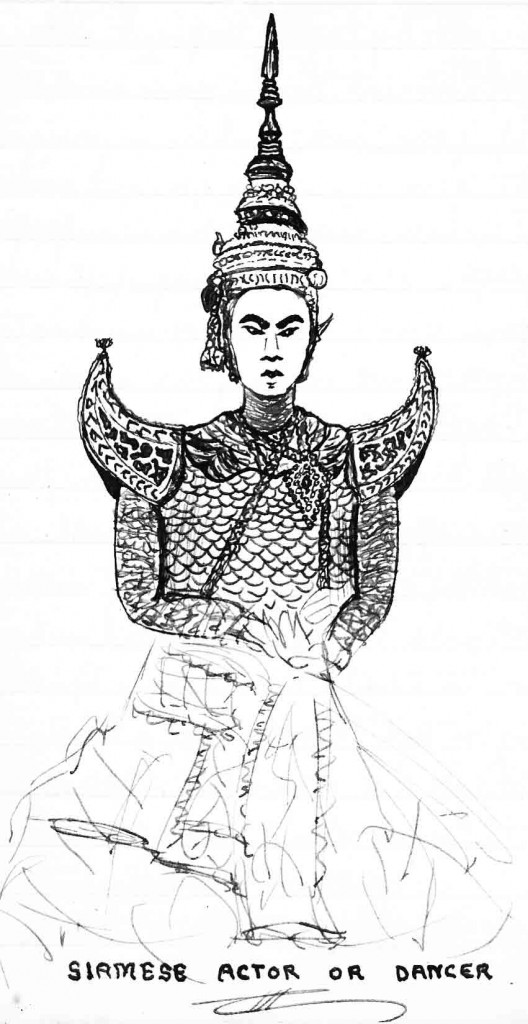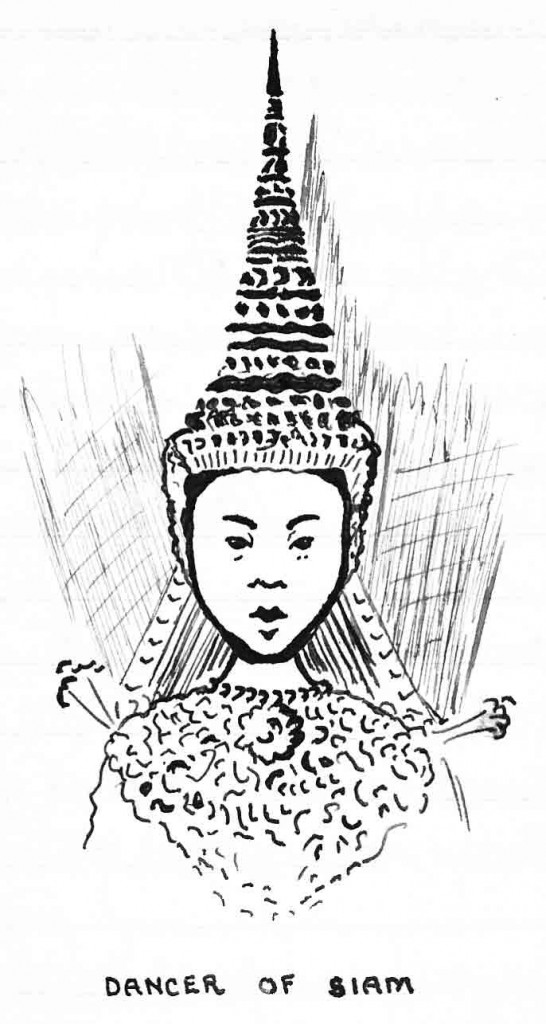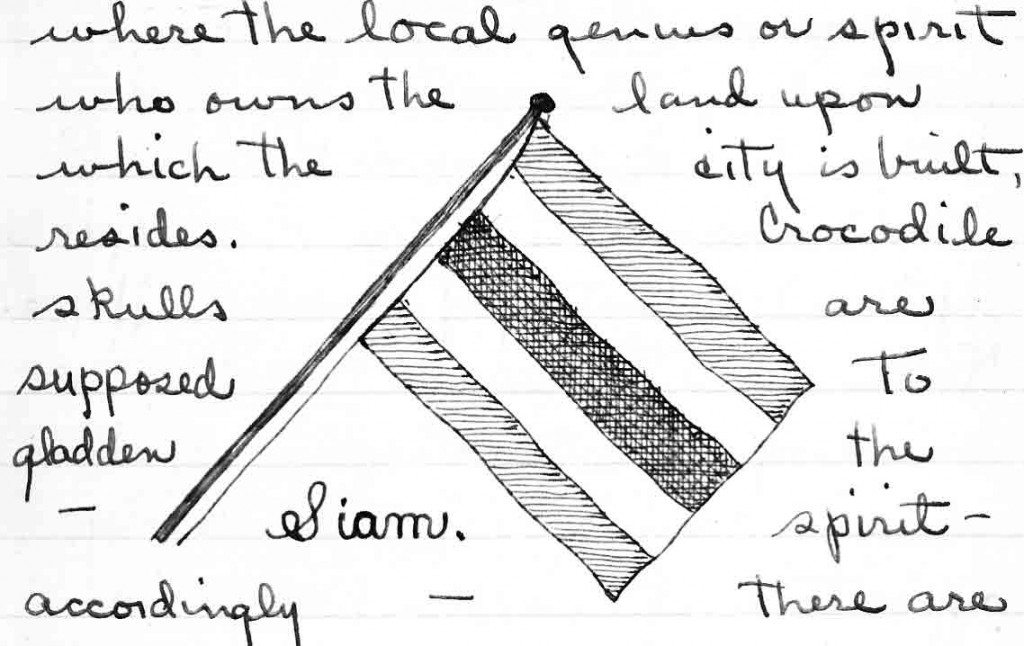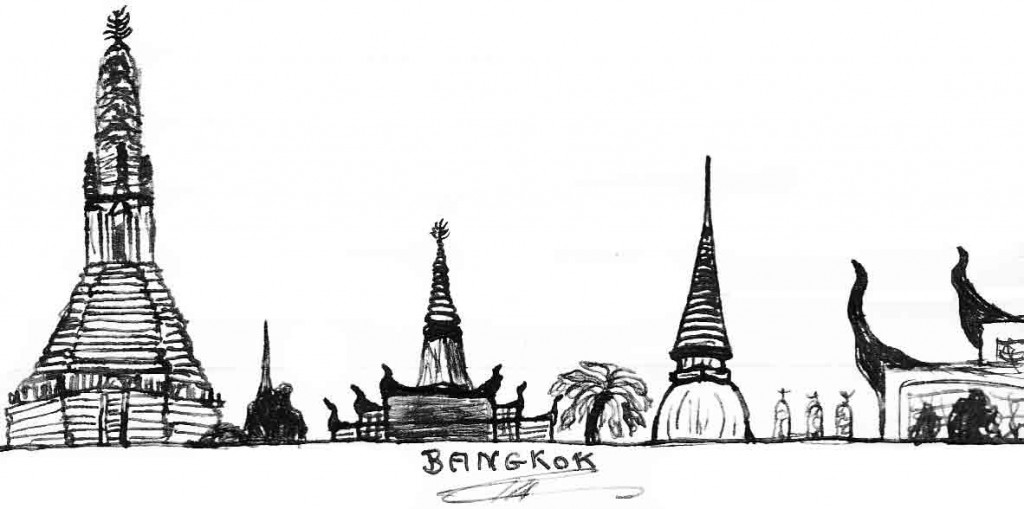Vendredi Juillet dix-neuf – Friday, July 19, 1929
Got the ferry at 8:50 AM and an hour later the train was pulling out. The morning soon grew cloudy so it was not hot at all. For once the train was uncrowded and I could stretch out and enjoy the jungle landscape. Some time during the afternoon we reached the Siamese border and went through customs, though I was not bothered beyond a half-hearted glance at my open suitcase. I had two or three people to talk to and some books, so the time did not pass too slowly. One young chap even produced an album of all the Siamese boxers—suppose you could call them boxers although they are permitted to use their arms, legs, feet, kick, and more than likely bite, if they haven’t too much betel juice in their mouths.
The chewing of betel-nut is a repulsive sight—much worse than tobacco. It stains the lips red and makes the tongue and teeth a reddish-black. The red saliva drips from the mouth and wherever the person expectorates is left a large red splotch. A person may be rather attractive till down drops a jaw exposing to view—if they aren’t too black—the most nauseating sight imaginable. And the worst part of it is that the chewers let their mouths hang open, often with half of their chew hanging out. So many of those addicted to this lovely habit have ape-like features and a protruding lower jaw that I am beginning to think that nature has come through with a jaw that has a greater capacity. Accompanying water-color will reveal the dominate type of topography to be found among the betel chewers of Siam.
 The features of the Siamese are similar to those of the Chinese a good deal, though the complexion is darker as a rule—yet lighter than the Indians. In stature the average must be near 5’6″. They appear to be a happy people, laughing and smiling, something rather rarely seen in India. The men can lay no claims to beauty, but some of the women are attractive. The kids are often very cute.
The features of the Siamese are similar to those of the Chinese a good deal, though the complexion is darker as a rule—yet lighter than the Indians. In stature the average must be near 5’6″. They appear to be a happy people, laughing and smiling, something rather rarely seen in India. The men can lay no claims to beauty, but some of the women are attractive. The kids are often very cute.
As to clothes—the kids in the country don’t bother. You see them splashing about in a small canal or creek or playing under a tree during the day, and just before dark they help their papa drive home the water buffaloes from the fields. These latter lead an insipid sort of a life. When there is no plowing to be done, they eat all day, or if there is water near, they submerge themselves till only their nose protrudes—and enjoy life.
Those more well-to-do children dress as their mother or father. The true native outfit—not influenced by European styles—consists of two pieces, sometimes three, and rarely one. The main piece is similar to that ugly-looking affair worn by the Hindus in India, a cloth as long as a skirt wrapped once about the waist, and the ends in front brought down between the legs and tucked in the back of the waist—very sloppy to look at, even more so here than in India for instead of white linen or cheesecloth is a dull, dirty black or brown cloth. A do-hunkus chemise or whatever you call them hangs from the shoulders to the waist. Often this is much abbreviated and a regulation size worn over all.  No shoes—unless it be wood ones, a flat board sole-shaped with a thong for the toes to hold it on. A flying boyish bob with shingle attached seems to be the popular method of cutting the jet-black hair though you do see long hair. The women thus far have impressed me as being rather stockily built and bow-legged—not at all graceful like Indian women. But in their defense I will say that the sloppy outfit they wear tends to show them off to disadvantage and perhaps magnify the defects, etc.
No shoes—unless it be wood ones, a flat board sole-shaped with a thong for the toes to hold it on. A flying boyish bob with shingle attached seems to be the popular method of cutting the jet-black hair though you do see long hair. The women thus far have impressed me as being rather stockily built and bow-legged—not at all graceful like Indian women. But in their defense I will say that the sloppy outfit they wear tends to show them off to disadvantage and perhaps magnify the defects, etc.
 The men are harder and sport a greater variety of garb. Soldiers and railroad employees wear khaki, long trousers, coat with high, tight-fitting collar, and a khaki cap. A great many civilians wear practically the same sort of an outfit except the lines are less stiff and the cap is replaced by a sun bonnet or slouch hat. Others wear an affair similar to that worn by the women except the colors are more gay and the hanging affair is replaced by a white loose-hanging shirt full of collar-buttons for buttons and with no collar. Some of the flaming youths appear in a pair of trousers that are a cross between sailor pants, oxford bags and shirts and drooping drawers. They are of white rayon or silk and appear cool. Coolies wear a regular Chinese outfit—loose pants and hanging jacket—mostly of a black silky cloth. In the fields the messy and coolie types are worn with big Chinese or Siamese straw hats.
The men are harder and sport a greater variety of garb. Soldiers and railroad employees wear khaki, long trousers, coat with high, tight-fitting collar, and a khaki cap. A great many civilians wear practically the same sort of an outfit except the lines are less stiff and the cap is replaced by a sun bonnet or slouch hat. Others wear an affair similar to that worn by the women except the colors are more gay and the hanging affair is replaced by a white loose-hanging shirt full of collar-buttons for buttons and with no collar. Some of the flaming youths appear in a pair of trousers that are a cross between sailor pants, oxford bags and shirts and drooping drawers. They are of white rayon or silk and appear cool. Coolies wear a regular Chinese outfit—loose pants and hanging jacket—mostly of a black silky cloth. In the fields the messy and coolie types are worn with big Chinese or Siamese straw hats.
I like the idea of going into a free country. Siam is ruled by a king who resides in Bangkok, and is, outwardly at least, under no obligation to any country.
Darned if they didn’t come through the car and charge everyone one tical for riding at night, the plea being that then the car is a sleeper and you have the privilege of climbing up on the shelf, moving baggage down, and sweating to death. I tried it twice, then gave it up and tried sprawling out over two seats below where there was a breeze.
